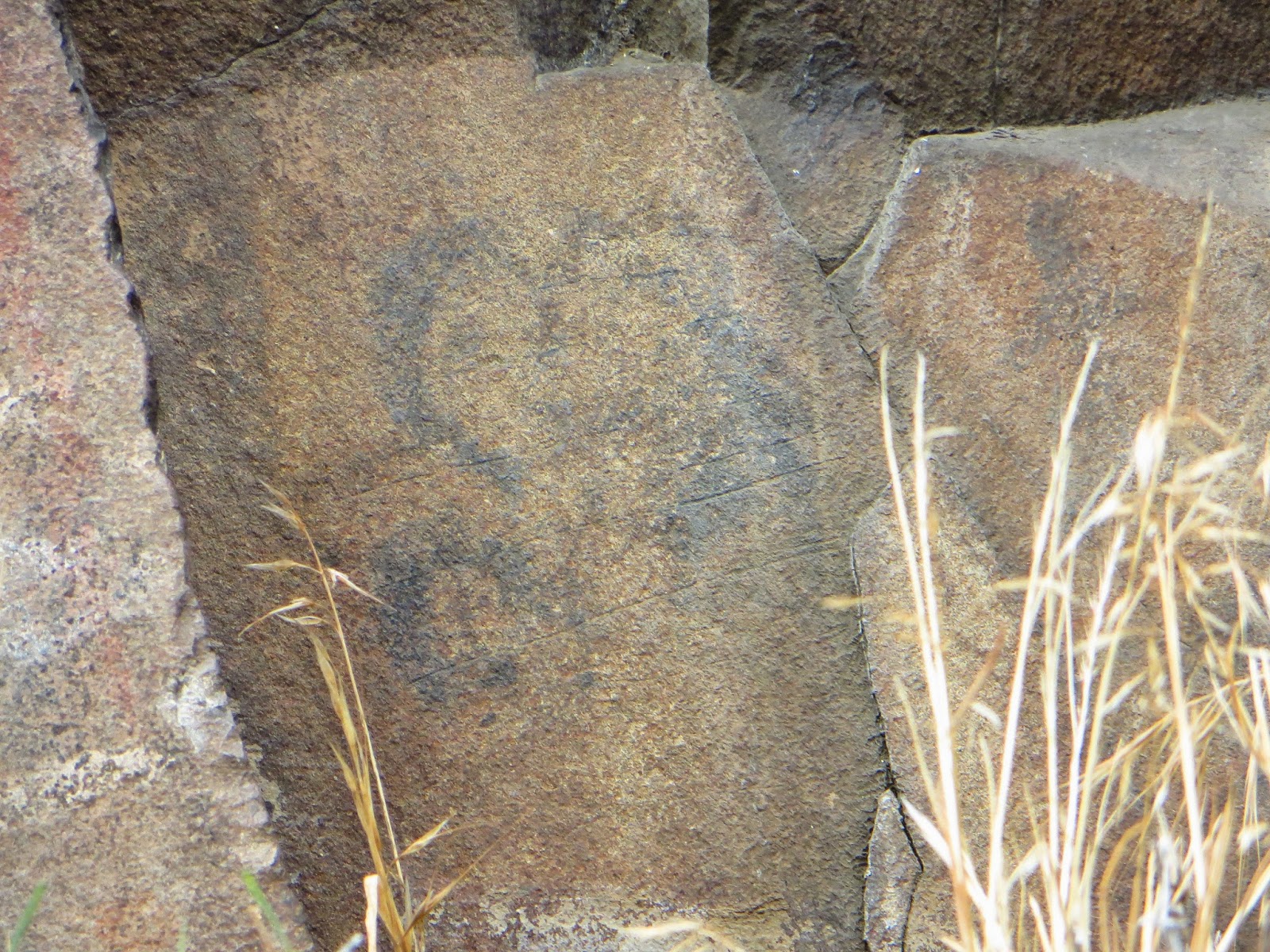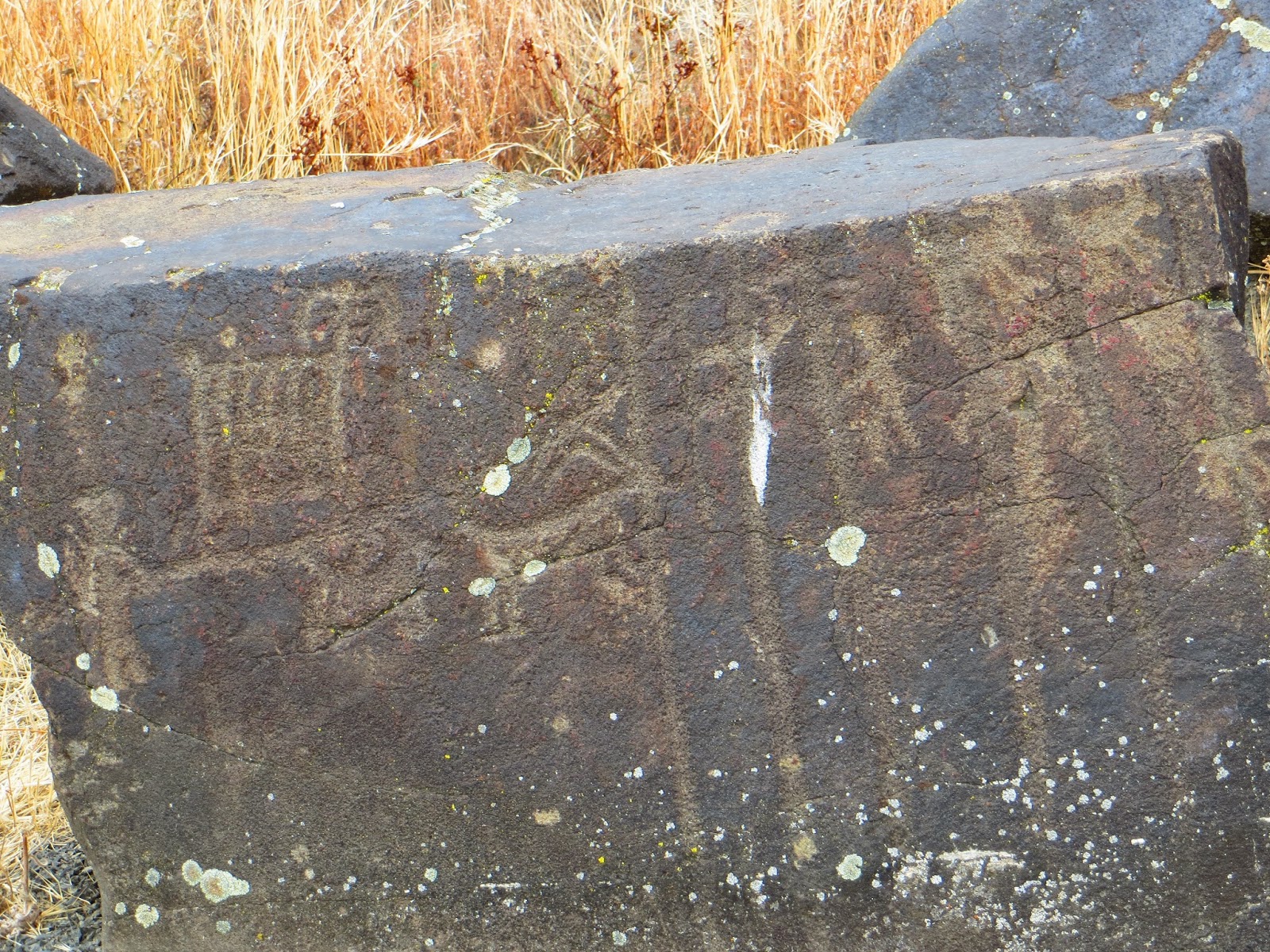 |
| Owl |
If you enjoy indoor museums, imagine pictures and carvings in an outdoor setting with room to ramble, explore and photograph at will. Throw in a vista or two, dry weather and an interesting mix of tourists and you have a trip to Dallasport, WA, to visit the famous Native American
rock art display. Escaping a rainy day in Portland I ventured east across the invisible dividing line at Hood River where Douglas firs, deciduous trees and mossy green are exchanged for Ponderosa pines, sage brush and dried grass brown. Here the weather is often dry and sunny with Gorge winds rushing across the face of the craggy basalt canyon of the Columbia River. The rolling hills beyond the cliffs undulate like the folds on the skin of a
Shar-Pei dog.
This day I had a (required) reservation to
tour the petroglyphs and pictographs salvaged from the rising waters behind The Dalles dam, a hydroelectric project of the 1950's. Located in
Horse Thief State Park, part of the larger Columbia Hills State Park, it contains but a tiny sample of the extensive rock art created by local and visiting Native American Indians over 300 years ago. The bulk of the rock art is underwater now. Successive lava flows extruded a multi-faceted work surface of
basalt for artists who lived or gathered in this stretch along the river to trade goods at the annual market event. Grinding red ochre, clay, shells, charcoal and other substances the Indians produced red, white and black paints. They would prepare the basalt surface by sanding it smooth with river sand and sometimes grinding it into a concave shape or flake the edges of a pointed surface. They would then draw a picture of symbolic significance on the rock surface. Basalt is porous and would absorb the paint and then minerals would leach out of the rock through the paint to preserve the image. After 300 years these images remain clear and colorful despite the harsh weather of the area.
 |
| "She Who Watches" |
The images are most often of a spiritual nature, drawn by a shaman/medicine person or a youth seeking a rite of passage into adulthood. Some of the images have been interpreted by Native American advisors but others remain a mystery. Images include a hand print, a tally, animals, spirit faces, water, salmon, owls and geometric shapes. The most famous image is seen at the end of the tour and is called "She Who Watches". It is a very large face with bear-like ears and huge eyes. It sits high above the trail and originally watched over a burial site. The remains were relocated to various tribal burial grounds prior to Lake Celilo forming behind the dam. Here is a
tale of the icon.
Lewis and Clark journeyed through this land on their way to the Pacific Ocean in 1805-6. Despite their extensive journaling they did not mention much about the rock art of this area. They seemed more focused on surviving the Narrows, a place where the 450 foot wide Columbia passed wildly through a 45 foot wide slot in the canyon. They returned a year later on the south side of the river.
Here,
here and
here are some interesting links to investigate. The
geologic history of the Pacific Northwest is also a fascinating study.
Rather than spend another thousand words describing the petroglyphs (rock carvings) and pictographs (rock paintings), I will let the pictures tell the story. A first-hand viewing of these pieces far surpasses the pictures. Plan a trip east for an adventure into history.
* With apologies to L. Frank Baum, author of The Wizard of Oz
 |
| Columbia Hills S.P. scenery |
 |
| Signage at the display |
 |
| Petroglyph examples |
 |
| Concave surface |
 |
| Elk |
 |
| Story board? |
 |
| Close-up view of sheep/goats |
 |
| Eagle or owl |
 |
| Petroglyphs' setting |
 |
| Token of worship left on fence post |
 |
| Reclining due to break in rock |
 |
| River barge traffic: recycled trees and cars |
 |
| close up view |
 |
| Pictograph example |
 |
| Basalt surfaces |
 |
| Lake Celilo |
 |
| Grass and basalt |
 |
| Trains every 30 minutes |
 |
| Train art |
 |
| Tally marks in red (small finger sized) |
 |
| Figure |
 |
| Hand detail |
 |
| Paula our excellent tour guide |
 |
| Sacred offerings left at site |
 |
| Juvenile's hand print |
 |
| Trail |
 |
| River waters |
 |
| Unusual flaked edge |
 |
| Obsidian flakes from "flaking site" area |
 |
| Red image |
 |
| Lichens around image |
 |
| Figure with bow and arrows |
 |
| Vandal's purple paint |
 |
| Rough fencing |
 |
| "She Who Watches" on high |
 |
| More sacred offerings |
 |
| Passing train passengers would fire bullets into "She....'s " eyes |
 |
| Flaking stations: a gathering work site |
 |
| View upriver |
 |
| Rocky burial site |
 |
| Petroglyph carving |
 |
| Site view |
 |
| Petroglyph |
 |
| View downriver |
 |
| Pictograph |
 |
| Petroglyph |
 |
| A serious warning |
 |
| Close-up of carvings |
 |
| Basalt cliffs and rolling hills |
 |
| Teepee at Columbia Hills S.P. |
 |
| Private cemetery |









































































No comments:
Post a Comment